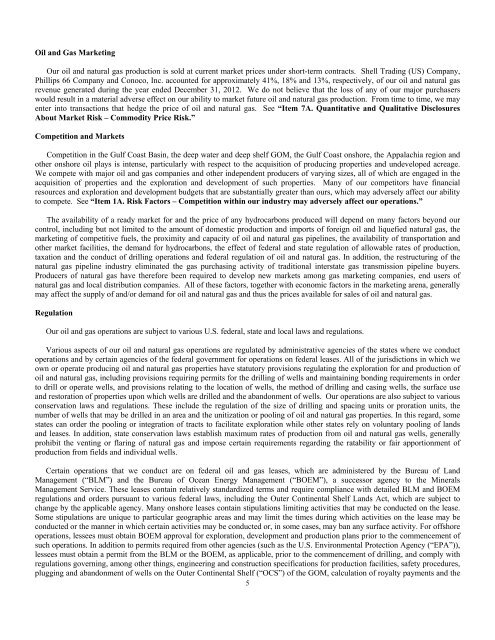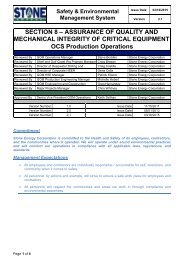2012 Annual Report - Stone Energy Corporation
2012 Annual Report - Stone Energy Corporation
2012 Annual Report - Stone Energy Corporation
You also want an ePaper? Increase the reach of your titles
YUMPU automatically turns print PDFs into web optimized ePapers that Google loves.
Oil and Gas MarketingOur oil and natural gas production is sold at current market prices under short-term contracts. Shell Trading (US) Company,Phillips 66 Company and Conoco, Inc. accounted for approximately 41%, 18% and 13%, respectively, of our oil and natural gasrevenue generated during the year ended December 31, <strong>2012</strong>. We do not believe that the loss of any of our major purchaserswould result in a material adverse effect on our ability to market future oil and natural gas production. From time to time, we mayenter into transactions that hedge the price of oil and natural gas. See “Item 7A. Quantitative and Qualitative DisclosuresAbout Market Risk – Commodity Price Risk.”Competition and MarketsCompetition in the Gulf Coast Basin, the deep water and deep shelf GOM, the Gulf Coast onshore, the Appalachia region andother onshore oil plays is intense, particularly with respect to the acquisition of producing properties and undeveloped acreage.We compete with major oil and gas companies and other independent producers of varying sizes, all of which are engaged in theacquisition of properties and the exploration and development of such properties. Many of our competitors have financialresources and exploration and development budgets that are substantially greater than ours, which may adversely affect our abilityto compete. See “Item 1A. Risk Factors – Competition within our industry may adversely affect our operations.”The availability of a ready market for and the price of any hydrocarbons produced will depend on many factors beyond ourcontrol, including but not limited to the amount of domestic production and imports of foreign oil and liquefied natural gas, themarketing of competitive fuels, the proximity and capacity of oil and natural gas pipelines, the availability of transportation andother market facilities, the demand for hydrocarbons, the effect of federal and state regulation of allowable rates of production,taxation and the conduct of drilling operations and federal regulation of oil and natural gas. In addition, the restructuring of thenatural gas pipeline industry eliminated the gas purchasing activity of traditional interstate gas transmission pipeline buyers.Producers of natural gas have therefore been required to develop new markets among gas marketing companies, end users ofnatural gas and local distribution companies. All of these factors, together with economic factors in the marketing arena, generallymay affect the supply of and/or demand for oil and natural gas and thus the prices available for sales of oil and natural gas.RegulationOur oil and gas operations are subject to various U.S. federal, state and local laws and regulations.Various aspects of our oil and natural gas operations are regulated by administrative agencies of the states where we conductoperations and by certain agencies of the federal government for operations on federal leases. All of the jurisdictions in which weown or operate producing oil and natural gas properties have statutory provisions regulating the exploration for and production ofoil and natural gas, including provisions requiring permits for the drilling of wells and maintaining bonding requirements in orderto drill or operate wells, and provisions relating to the location of wells, the method of drilling and casing wells, the surface useand restoration of properties upon which wells are drilled and the abandonment of wells. Our operations are also subject to variousconservation laws and regulations. These include the regulation of the size of drilling and spacing units or proration units, thenumber of wells that may be drilled in an area and the unitization or pooling of oil and natural gas properties. In this regard, somestates can order the pooling or integration of tracts to facilitate exploration while other states rely on voluntary pooling of landsand leases. In addition, state conservation laws establish maximum rates of production from oil and natural gas wells, generallyprohibit the venting or flaring of natural gas and impose certain requirements regarding the ratability or fair apportionment ofproduction from fields and individual wells.Certain operations that we conduct are on federal oil and gas leases, which are administered by the Bureau of LandManagement (“BLM”) and the Bureau of Ocean <strong>Energy</strong> Management (“BOEM”), a successor agency to the MineralsManagement Service. These leases contain relatively standardized terms and require compliance with detailed BLM and BOEMregulations and orders pursuant to various federal laws, including the Outer Continental Shelf Lands Act, which are subject tochange by the applicable agency. Many onshore leases contain stipulations limiting activities that may be conducted on the lease.Some stipulations are unique to particular geographic areas and may limit the times during which activities on the lease may beconducted or the manner in which certain activities may be conducted or, in some cases, may ban any surface activity. For offshoreoperations, lessees must obtain BOEM approval for exploration, development and production plans prior to the commencement ofsuch operations. In addition to permits required from other agencies (such as the U.S. Environmental Protection Agency (“EPA”)),lessees must obtain a permit from the BLM or the BOEM, as applicable, prior to the commencement of drilling, and comply withregulations governing, among other things, engineering and construction specifications for production facilities, safety procedures,plugging and abandonment of wells on the Outer Continental Shelf (“OCS”) of the GOM, calculation of royalty payments and the5









